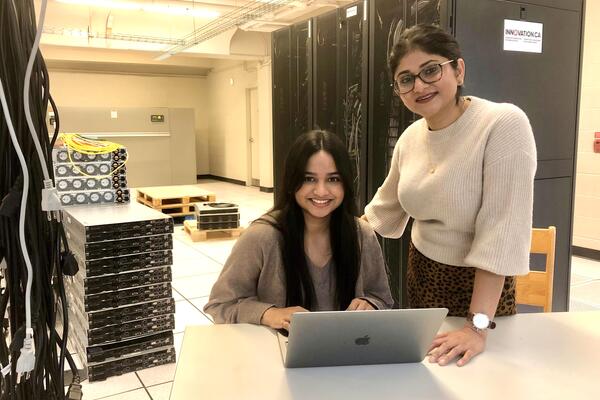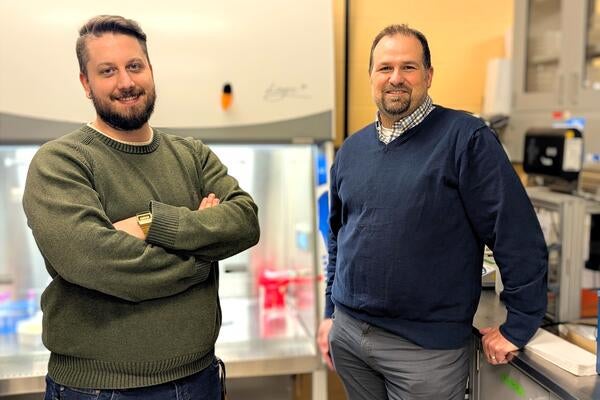
Detecting infrastructural issues in time
Waterloo professor uses 5G to power technology that helps improve structural safety

Waterloo professor uses 5G to power technology that helps improve structural safety
By Alex Kinsella Faculty of EngineeringMillions of people and vehicles rely on bridge infrastructure to get from point A to point B every day. But the potential for catastrophic failure grows as bridges and other transportation infrastructure age.
According to the 2021 Infrastructure Report Card, there are over 617,000 bridges in the U.S., almost half being at least 50 years old. It is not only age that affects these bridges' reliability and structural integrity. Additional stresses from events such as hurricanes, earthquakes and heat waves are compromising structural durability and longevity too.
Disaster mitigation through tech
Dr. Chul Min Yeum, an assistant professor in the civil and engineering department at the University of Waterloo, leads a team of researchers using technologies like 5G and augmented reality to identify structural issues in bridges, buildings and other infrastructure before disaster strikes.
Yeum joined Waterloo's Faculty of Engineering in 2018 after completing his PhD in civil engineering at Purdue University. Throughout his studies and research, Yuem has focused on non-destructive testing and structural health monitoring for man-made structures such as bridges, buildings, and air vehicles.
 Dr. Chul Min Yeum, assistant professor in the civil and engineering department, is improving disaster detection tech with 5G.
Dr. Chul Min Yeum, assistant professor in the civil and engineering department, is improving disaster detection tech with 5G.
The timing of Yuem’s PhD research coincided with a significant moment in the field of deep learning. In 2012, University of Toronto professor and AI expert Geoffrey Hinton co-authored the paper “ImageNetClassification with Deep Convolutional Neural Networks.” The paper is credited with promoting the value of deep learning in improving image recognition accuracy.
“It inspired me to adopt the algorithm to detect damages in a structure,” says Yeum. “Think of hurricanes as an example. Engineers often conduct extensive surveys, capturing hundreds of photos of various structures. This rich dataset plays a crucial role in understanding the factors that led to the failure of one structure while another remained intact.”
Improved efficiency with 5G
Computer vision and deep learning can provide civil engineers with better insights than ultrasonic detection. But the technologies require a much larger data set. Yuem’s research also looks at remote real-time analysis adding to the data and communication requirements. Yuem says he did not have to look far to find help thanks to the University’s Rogers 5G Partnership.
“The major issue of using AI technologies like deep learning and computer vision in remote civil engineering is the level of trust in their accuracy. AI can be up to 99% accurate, but engineers want it to be 100%, so they end up visiting a site in person,” Yuem says.
“What if we could utilize 5G infrastructure to develop intricate, immersive representations of job sites, thereby facilitating seamless collaboration between remote human engineers and their robotic counterparts?”
5G cellular networks provide more bandwidth and higher speeds to send more data across the network faster. But the real value is the technology’s ability to significantly reduce the power requirements for 5G-enabled mobile and wearable devices used for field inspection.
“For example, say a robot is collecting images of a bridge and it detects damage. The human engineer can review the analysis, but they have no context for where the damage is or the history of the structure. Using augmented reality glasses, the engineer can look at the structure, see the damage identified by the robot and review historical images of the structure so they can make the best analysis possible,” says Yuem.
Customized research tools
Collecting image data for this type of non-destructive testing requires specialized cameras and sensors. These types of commercial equipment, including LiDAR camera systems, can cost upwards of $200,000. Yuem says many commercial sensors were developed for other use cases that do not make them ideal for his research. To solve this, his team has developed their own equipment.
“My grad students are building a custom data collection system by assembling individual sensors,” Yuem says. “Right now, we have many different versions of the scanner that we can mount on a robotic platform or a handheld scanner. We even made a backpack scanner to make it easier to collect data on site.”
Detecting structural damage is challenging work. Yuem’s unique approach to employing computer vision and deep learning is aimed at developing solutions to prevent severe injuries and deaths caused by structural collapses. Whether those defects are caused by age or natural disaster, Yuem says the combination of human engineers and remote robots can help accurately detect issues in time – as well as drive engineering advances for future structures.
“5G is helping us create a platform where humans and AI work together to improve structural safety through an enhanced visual inspection process,” says Yuem.
Feature image: Dr. Chul Min Yeum (centre) with his research team. Photo credit: Martin Schwalbe.

Read more
Here are the people and events behind some of this year’s most compelling Waterloo stories

Engineering master's student Nayeema Nonta (left), one of the three paper authors, and her supervisor, Dr. Sirisha Rambhatla, in a large server room with the computer power needed to develop their new LLM training technique. (University of Waterloo)
Read more
Waterloo researchers develop highly efficient AI training system that paves the way for cheaper, greener “intelligent partners”

Read more
Engineering researchers team up to tackle the plastics pollution problem with microbial innovation and engineering design
The University of Waterloo acknowledges that much of our work takes place on the traditional territory of the Neutral, Anishinaabeg, and Haudenosaunee peoples. Our main campus is situated on the Haldimand Tract, the land granted to the Six Nations that includes six miles on each side of the Grand River. Our active work toward reconciliation takes place across our campuses through research, learning, teaching, and community building, and is co-ordinated within the Office of Indigenous Relations.